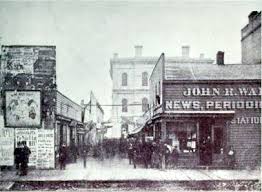In December of 1871, he leased a lot on Clinton Street between Randolph and Washington Streets in the unburned west side just after the Great Chicago Fire in 1871, and in 1872, erected Nixon’s Parisian Hippodrome and Nixon's Amphitheatre, which was planned and erected within a fortnight (two weeks), opening on May 18, 1872. Hundreds of people were turned away on opening day because of overcrowding.
 |
| Nixon’s Amphitheater Clinton Street, Looking South from Randolph Street. |
The front of the edifice (a large, imposing building) presented an attractive appearance, with gas jets extending the entire length and an elegant arch over the entrance. The auditorium is circular in shape and has ten tiers of seats descending to the ring. The interior was arranged with chairs from the ring to the canvas top, and a commodious promenade was adorned by panels elaborately illustrated with scenes from the sports and pastimes of former years, rendered by the well-known Chicago artist R.W. Wallis.
The Amphitheater was lighted with gas, thoroughly ventilated, and could comfortably accommodate 2,500 people. Admission to the show was 50¢ for the parquet (main seating area in a theater closest to the orchestra or stage) and dress circle (a curved section or tier of seats, usually the first tier above the orchestra), 75¢ for the reserved chairs, and 25¢ for children under ten.
Under this headline should be classed the pedestal gymnastics of Master F. Runnells, whose movements were so rapid as to literally shake the clothes off his body, resulting in an awkward predicament. Signor Francis’ juggling was an artistic performance, and Mr. H. Wambold introduced some striking feats in trapeze balancing. The dancing horse “Blind Tom,” under the skillful guidance of Miss Ella Stokes, was a gem in its line, and the posturing and contortion act or Mr. G. Wambold, the horizontal bar by the Laisesli Brothers, Kline and Murtz, the trapeze business of the Laiseli Brothers, and the show by Masters Fred and Barney, were all received with great applause. But the finest feature of the evening, indeed, the finest thing of Mr. George Wambold’s trained dogs and monkeys, which alone would repay a visit to the amphitheater. There was manifest on the part of the management a determination to cater only to the very best class of patrons with careful regard for delicacy and refinement. Mr. Nixon gives assurance that such will be the rigid rule of the establishment, and he also promises to bring out from time to time novelties and varieties of the highest order of excellence.
 |
| Chicago Tribune, May 20, 1872 |
 |
| Prairie Farmer, June 22, 1872 |
 |
| Chicago Tribune, July 27, 1873 |
Compiled by Dr. Neil Gale, Ph.D.





